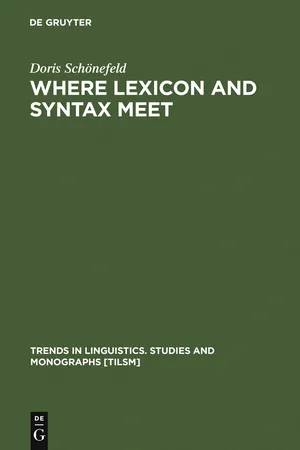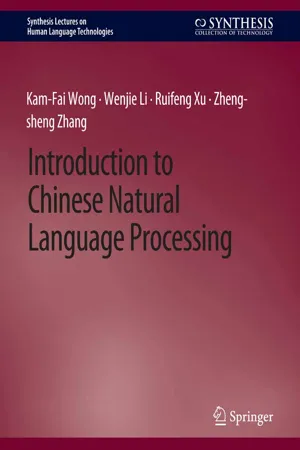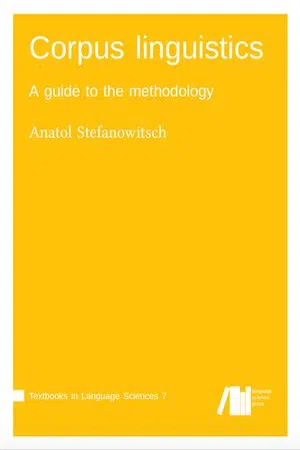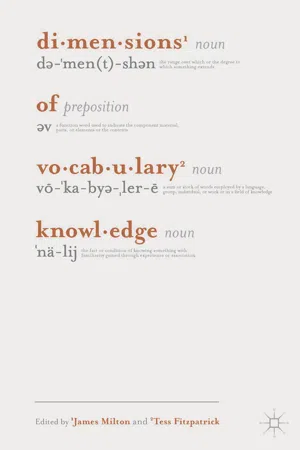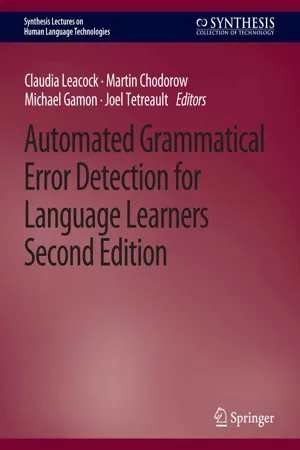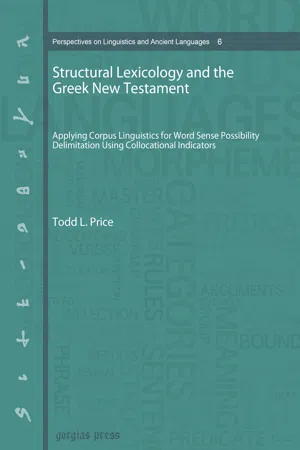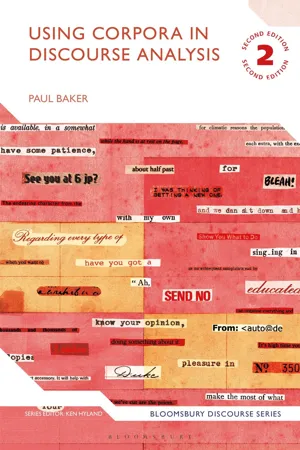Languages & Linguistics
Collocations
Collocations are combinations of words that frequently occur together in a language. They are important in understanding the natural use of language and can vary across different languages and dialects. Collocations can include verb-noun combinations, adjective-noun pairings, and other word combinations that are commonly used together in speech and writing.
Written by Perlego with AI-assistance
Related key terms
1 of 5
12 Key excerpts on "Collocations"
- eBook - PDF
- Doris Schönefeld(Author)
- 2011(Publication Date)
- De Gruyter Mouton(Publisher)
77 This understanding of meaning goes back to Malinowski, who - according to Steiner (1983: 57-58) - defines meaning by referring to both function and context: Meaning is function in context, it is use of language and not concept. The Lexical co-occurrences 229 his definition of collocation: The habitual Collocations in which words under study appear are quite simply the mere word accompaniment .... Collocations are actual words in habitual company. This very general characterization has been further specified and elaborated by linguists who enquire into the phenomenon of co-occurrence preferences/restrictions. Altenberg & Eeg-Olofsson (1990: 3) differentiate between a broader and a stricter sense in which the term collocation is used and understood in linguistics, with the former being equivalent to recurrent word combination, and the latter to habitually co-occurring lexical items or mutually selective items. As can be easily seen, it is this latter sense that follows from the Firthian definition. For the two senses of the term Altenberg & Eeg-Olofsson (1990: 3) further specify: Both interpretations imply a syntagmatic relationship between linguistic items, but whereas the broad sense focuses on word sequences in texts, the stricter sense goes beyond this notion of textual co-occurrence and emphasizes the relationship between lexical items in a language (...) That means that Collocations in a stricter sense seem to have become part of the inventory of a language's elements, they seem to have acquired the status of single (though obviously analysable) elements that are disposable for the further (rule-governed) construction of utterances. From my point of view, this status cannot be attributed to all the Collocations alike, since there are differences in their entrenchment in a language user's linguistic repertoire. - Kam-Fai Wong, Wenjie Li, Ruifeng Xu, Zheng-sheng Zhang(Authors)
- 2022(Publication Date)
- Springer(Publisher)
A grammatical collocation is defined as a phrase consisting of a dominant word plus a particle. Typical grammatical Collocations include verb+preposition (abide by, account for), noun+preposition (access to), and adjective+preposition (absent from). A lexical collocation is a combination of nouns, adjec- tives, verbs, and adverbs, but it does not include prepositions, infinitives, or clauses. The categoriza- tion of Benson et al. [1986] guided the compilation of the BBI Combinatory Dictionary of English. In Benson’s collocation framework, grammatical restrictions dominate. Recurrent co-occurrence is not an essential feature for a collocation. Later, Benson [1990] generalized the notion of collocation to an arbitrary and recurrent word combination. This definition is adopted by many computational linguists [Smadja 1993; Sun et al. 1997]. Furthermore, semantic restrictions within Collocations are studied. Carter [1987] pointed out that syntactic and semantic statements were often essential in studying Collocations. Some research- CHINESE Collocations 97 ers proposed that Collocations should only be word combinations whose whole meanings could not be predicted from their components. There are other researchers who thought that such a restriction was too strict and hence would be impractical [Allerton 1984]. In corpus linguistics, collocation is defined (see Wikipedia) as a sequence of words or terms which co-occur more often than would be expected by chance. Some researchers emphasize the habitual and recurrent use of Collocations [Gistak 2000]. Similarly, Manning and Schütze [1999] stated that “a collocation is an expression consisting of two or more words that correspond to some conventional way of saying things.” It is clear that many corpus linguistic researchers are engaged in the identification and study of habitual use of lexical items which is also applicable to NLP research.- eBook - PDF
Collocations and Action Research
Learning Vocabulary through Collocations
- Joshua Brook Antle(Author)
- 2018(Publication Date)
- Bloomsbury Academic(Publisher)
2 Collocations, Units of Meaning, and Formulaic Language 2.1 Introduction The definition for “collocation” is important because it influences what language structures are considered to be Collocations in different studies. Collocations have been widely researched, and as a result researchers have attributed different characteristics to the term collocation depending on their specific field of research. However, it is possible to categorize the various defi-nitions into two general groups: statistical and phraseological. Researchers using a statistical definition tend to be corpus linguists who emphasize fre-quency as a trait of Collocations. Other researchers use a phraseological definition that, while still acknowledging the importance of frequency, also accentuates other characteristics such as semantics, syntax, and the mental lexicon. Language acquisition involves the storage of Collocations in the mental lexi-con, and producing fluent speech requires the quick retrieval of Collocations from the mental lexicon. The differences and similarities between how children acquire their L1 and adults acquire an L2 are discussed in regard to language acquisition and collocation usage. The discussion then focuses on the problems L2 adults face when acquiring collocational competence and the relevant studies in this area. Various corpora programs are compared and contrasted in consideration of their usefulness for collocation research and teaching. The research done using corpora programs has also been used to distinguish between the two main groups of definitions for the term collocation, which is described in Section 2.2: statistical and phraseological. In addition, studies using a corpus and pro-posals for how a corpus can be of pedagogical value are presented along with the common criticisms of corpus research. - Hans Lindquist, Magnus Levin(Authors)
- 2018(Publication Date)
- EUP(Publisher)
72 4 Checking Collocations 4.1 Two types of Collocations As pointed out by e.g. the psycholinguist Alison Wray, the tendency in speakers to use groups of words together as multi-word units or phrases is a phenomenon which has been acknowledged by linguists like de Saussure, Jespersen, Bloomfield and many others over the years (cf. Wray 2002: 7 for references). Wray is looking for the rationale behind this human inclination to use ‘words and strings of regular as well as irregular construction’ (2002: 279), and suggests that the explanation lies in the human learning and storing process on the one hand and the retrieval process on the other (2002: 100–2). The ability to combine words in the right way is the key to native-like fluency. Even speakers of English as a second language with an almost perfect command of the language often deviate slightly in the choice of words which marks them as non-natives. The first important work on word combinations using the term ‘collocation’ was the pedagogically motivated Second Interim Report on English Collocations by the educationalist H. E. Palmer, published rather obscurely in Japan in 1933. It offers the following definition: A collocation is a succession of two or more words that must be learnt as an integral whole and not pieced together from its component parts. (1933: title page) Palmer classified the Collocations according to a number of patterns. Figures 4.1 and 4.2 illustrate how the Collocations were presented in his book. We think the reader will recognise all or most of these word combi-nations as phrases that it would be useful for a learner to master. They all consist of a more or less fixed string, sometimes with an open slot where there is some variation. The British linguist Firth used the term ‘collocation’ in a rather different sense, and his statement that ‘[y]ou shall know a word by the CHECKING Collocations 73 company it keeps’ (1957: 11) is often quoted.- Anatol Stefanowitsch(Author)
- 2020(Publication Date)
- Language Science Press(Publisher)
7 Collocation The (orthographic) word plays a central role in corpus linguistics. As suggested in Chapter 4, this is in no small part due to the fact that all corpora, whatever additional annotations may have been added, consist of orthographically repre-sented language. This makes it easy to retrieve word forms. Every concordancing program ofers the possibility to search for a string of characters – in fact, some are limited to this kind of query. However, the focus on words is also due to the fact that the results of corpus linguistic research quickly showed that words (individually and in groups) are more interesting and show a more complex behavior than traditional, grammar-focused theories of language assumed. An area in which this is very obvious, and which has therefore become one of the most heavily researched areas in corpus linguistics, is the way in which words combine to form so-called Collocations . This chapter is dedicated entirely to the discussion of collocation. At frst, this will seem like a somewhat abrupt shif from the topics and phenomena we have discussed so far – it may not even be immediately obvious how they ft into the defnition o f corpus linguistics as “the investigation of linguistic research ques-tions that have been framed in terms of the conditional distribution of linguistic phenomena in a linguistic corpus”, which was presented at the end of Chapter 2. However, a closer look will show that studying the co-occurrence of words and/ or word forms is simply a special case of precisely this kind of research program. 7.1 Collocates Trivially, texts are not random sequences of words. There are several factors in-fuencing the likelihood o f two (or more) words occurring next to each other. First, the co-occurrence of words in a sequence is restricted by grammatical considerations.- (Author)
- 2015(Publication Date)
- Cuvillier Verlag(Publisher)
Compare also Sinclair (1991), whose analyses show similar results. A third aspect implied in Stubbs’ definition of collocation above is that Collocations are usually observed within a specific span of words, a criterion that Sinclair addresses at several points, for example: [Collocation is] the occurrence of two or more words within a short space of each other in a text. (Sinclair 1991: 170) Collocation [ ] is the co-occurrence of words with no more than four intervening words. (Sinclair 1998: 15) Regarding the interpretation of patterns and their overlap, however, I would like to avoid defining a specific span and stick to a more general formulation by Dieses Werk ist copyrightgeschützt und darf in keiner Form vervielfältigt werden noch an Dritte weitergegeben werden. Es gilt nur für den persönlichen Gebrauch. 67 Sinclair, namely that “collocation illustrates the idiom principle” and that “[o]n some occasions, words appear to be chosen in pairs or groups and these are not necessarily adjacent ” (Sinclair 1991: 115; emphasis added LG). In sum, I would like to refer to collocation in this study whenever we can affirm a habitual co-occurrence 16 of word forms, which need not necessarily be adjacent. Furthermore, collocational behaviour, as has been discussed before, is observed on the least abstract lexical level of description implying lexical dependencies from a linear perspective. This is similar to an idea brought forward by Stubbs who refers to collocation as a “neutral term for a string of word[-form]s” (Stubbs 2001: 24), i.e. a lexical string illustrating the idiom principle (cf. Sinclair 1991: 115). Colligation has often been described as a more abstract or generalised form of collocation. Mitchell (1971: 53), for instance, describes the relation between collocation and colligation: Collocations are particular members of generalized classes of associations that we have labelled ‘colligations’.- eBook - PDF
- Míriam Buendía-Castro(Author)
- 2020(Publication Date)
- Peter Lang Group(Publisher)
Collocations in lexicography and terminography 48 Based on the previous considerations and for the purposes of this study, a collocation is a combination of two or more words� In our case, the struc- ture of such highly frequent combinations are noun + verb or verb + noun, where the noun is the base and the verb is the collocate� In this noun-centred type of collocation, the meaning of the collocate (the verb) is imposed by the meaning of the base (the noun), but at the same time, the collocate also constrains the arguments that can combine with it� Another important question to be addressed is where Collocations should appear in the micro and macrostructure of both general and specialized dictionaries so that information can be easily accessed by users� According to Fontanelle (1998, p� 295), the user should be able to access collocational information in various ways� However, most resources only allow users to access Collocations in the entry of the base: Multiple access points enable the linguist to access information via the base (the keyword, or element in italics), the collocate (the dictionary headword), the lex- ical function, the translation, or the part of speech, all of which means that this type of collocational dictionary can fill a gap in lexicography: indeed, traditional collocational dictionaries usually provide one type of access key only or simply list potential collocates without any attempt at formalizing the main collocational description of a lexeme can then be viewed as a semantic network in which a node (the base) is linked to its collocates through arrows (the lexical functions) which are labels for specific lexical semantic relationships� Potential applications of such a database range from language teaching to information retrieval and machine translation and, more specifically, language generation, where selecting the appropriate word in - eBook - PDF
- James Milton, Tess Fitzpatrick(Authors)
- 2017(Publication Date)
- Red Globe Press(Publisher)
Granger (2009; see also Granger and Paquot, 2008) has suggested the adoption of different terms for linguistically defined and quantitatively defined units, with collocation being reserved for the former and recurrent sequences or co-occurrents for the latter. However, it is also, of course, possible to com-bine the approaches. Several papers in Barfield and Gyllstad’s (2009) edited collection, for example, begin with frequency-based techniques using a cor-pus to produce a list of Collocations before then applying a phraseological approach to try to make sense of the items found. This combination is, in fact, seen in FDCAE (Davies and Gardner, 2010), discussed above, as, while the selection of Collocations for inclusion relies on frequency-based techniques, the organization of each entry is more phraseological, with the list of collocates for each word organized by part of speech and a symbol used to indicate whether the collocate typically appears before or after the word. Wray (2009) makes the point that there does not necessarily need to be uni-versal agreement on one definition of collocation, ‘but there is, I think, value in researchers reflecting on the implications of the definitions they use’ (p. 239). She argues that there is a need for researchers to consider carefully the defini-tions of collocation employed and the definitions implied by the methods they adopt and that they should be wary of adopting definitions simply because they follow on from convenient methods of identification or convenient meth-ods of data collection. Collocations and L2 learning and teaching Interest in Collocations as an aspect of word knowledge stems in part from the seemingly widespread view that learners struggle with formulaic language 126 KNOWLEDGE OF Collocations in general and Collocations in particular. - Claudia Leacock, Michael Gamon, Joel Alejandro Mejia, Martin Chodorow(Authors)
- 2022(Publication Date)
- Springer(Publisher)
65 C H A P T E R 6 Collocation Errors We know that words do not combine randomly in natural language, as their distributions are governed by both syntax and semantics. But beyond grammar and meaning, words also show tendencies or preferences in the ways they combine. As we noted in Chapter 3, native speakers of English know that the noun phrase powerful computer is preferred over strong computer, even though both are grammatically and semantically well formed. Examples of such arbitrary, con- ventional usage appear in many different syntactic constructions, including adjective + noun (stiff breeze instead of rigid breeze), verb + noun (hold an election instead of make an election; kick the bucket (in the die sense) instead of hit the bucket ), noun + noun or noun + of + noun (movie the- ater instead of film theater ; swarm of bees instead of crowd of bees), and adverb + verb (thoroughly amuse instead of completely amuse).¹ Preferred word combinations such as these were first termed “Collocations” by Firth [1957]. In the Firthian approach, the context of a word’s usage is seen as crucially important in determining the word’s meaning. is view underlies Firth’s now-famous dictum that “you shall know a word by the company it keeps.” 6.1 DEFINING Collocations Linguists have tried to define exactly what a collocation is. One proposed criterion is non- compositionality, which states that the meaning of the collocation is not entirely a function of its parts. Non-compositionality can be seen most clearly in idioms such as to kick the bucket, where the idiomatic meaning of the whole (i.e., to die) seems unrelated to the parts kick or bucket. However, many Collocations are indeed compositional (e.g., powerful computer ). Another proposed criterion is non-modifiability. Many Collocations cannot be freely modified without fundamentally altering their meaning. For example, to kick a plastic bucket has only the literal meaning, not the idiomatic one.- eBook - PDF
Structural Lexicology and the Greek New Testament
Applying Corpus Linguistics for Word Sense Possibility Delimitation Using Collocational Indicators
- Todd L. Price(Author)
- 2015(Publication Date)
- Gorgias Press(Publisher)
97 C HAPTER 5: C OLLOCATIONS AND C OLLIGATIONS (P ART 1) Our goal in this study is to show how the application of CL to NT Greek lexical semantics can assist us in disambiguating polysemes and in differentiating near synonyms. It is our argument that specific senses can often be disambiguated by noting the Collocations of the lexical item in question. We are not free to look up a word in a NT Greek-English lexicon and choose any of the listed definitions as applicable to a given NT verse. We must rather seek to determine which Collocations are normally used with which meanings. 5.1 C OLLOCATION Firth was the first to propose the term collocation 1 and he explained it by saying, ‘The placing of a text as a constituent in a context of situation contributes to the statement of meaning since situations are set up to recognize use … You shall know a word by the company it keeps!’ 2 He recognized the importance of a word’s Collocations as an essential step in determining meaning. 3 Collocations are helpful in two specific areas: 1) differentiating between two near synonyms (we will deal with this aspect less thoroughly in this study, but see 5.4.1 and 5.4.2); and 2) disambiguating the various senses of a polyseme (most of the discussion in this study centers on this principle; see 5.5.1–5.5.7). As an example of differentiating near synonyms, we can say that strong and powerful share components of meaning, yet they behave somewhat differently. We can say, The senator presented some strong arguments for his case , as well as The senator presented some powerful arguments for his case ; in other words, both strong and powerful collocate naturally with arguments . However, we would say, I like my coffee strong , but probably not *I like my coffee powerful . We would say, The testimony I heard in church this morning was powerful , but probably not *The testimony I heard in church this morning was strong . - eBook - PDF
- Paul Baker(Author)
- 2023(Publication Date)
- Bloomsbury Academic(Publisher)
It would be more convenient, at least at the beginning, to be simply given a list of words which tend to occur near or next to forgive relatively often – we can worry about where they actually appear and what their relationship means once we know what those words are. All words co-occur with each other to some degree. However, when a word regularly appears near another word, and the relationship is statistically 135 Using Corpora in Discourse Analysis 136 significant in some way, then such co-occurrences are referred to as collocates and the phenomena of certain words frequently occurring next to or near each other is collocation. As Firth (1957: 11) wrote: ‘You shall know a lot about a word from the company it keeps.’ Collocation is a way of understanding meanings and associations between words which are otherwise difficult to ascertain from a small-scale analysis of a single text. Stubbs (1996: 172) takes the point further: ‘words occur in characteristic Collocations, which show the associations and connotations they have, and therefore the assumptions which they embody’. In this chapter our case study involves the analysis of a 1.7 million word corpus of texts relating to Islam that were classified by experts working within the Home Office in the UK as being Extremist (170 texts in total). I refer to this as the Extreme Corpus. Such texts contain ‘endorsement/ glorification of violence in contemporary context and/or stark dehumanisation’ (Holbrook 2015: 60). The texts include news reports, magazines, interviews, lectures, biographies, political treatises, statements and guides on topics like bomb-making and computer encryption. Working with these kinds of texts requires special considerations from ethical and legal perspectives. Possession of these texts is illegal in the UK, and I obtained them from police authorities who engaged me to work on them. - eBook - PDF
Languages in Contact and Contrast
Essays in Contact Linguistics
- Vladimir Ivir, Damir Kalogjera, Vladimir Ivir, Damir Kalogjera(Authors)
- 2011(Publication Date)
- De Gruyter Mouton(Publisher)
That is why, as in Friederich's dictionary, space is simply wasted with the idio-matic expressions. 3. Collocations in British monolingual dictionaries for native speakers Let us look at the situation concerning the Collocations in British mon-olingual dictionaries. The first thing to notice is that in the big monolin-gual dictionaries for native speakers, such as the Collins Dictionary of the English Language or, more recently, the Longman Dictionary of the English Language, there is a basic lack of Collocations. Incidentally, this is in marked contrast to German dictionaries of the same type, such as the Duden Deutsches Universalwörterbuch or the Wahrig Deutsches Wörter-buch. But when the English monolingual dictionaries for native speakers include Collocations at all, they naturally do so in the entry of the collocator since Collocations are sometimes indispensable to supplement Collocations in monolingual and bilingual English dictionaries 231 the definition of the collocator. That explains why you will find in the entry to meet in the Collins Dictionary of the English Language the collocation to meet someone's demands, whereas there is no collocation in the entry demand. The situation is quite similar in the case of most American dictionaries including the so-called College Dictionaries, which have traditionally contained only a very small number of collo-cations. Here, by the way, the Chambers Twentieth Century Dictionary takes first prize: it does not list a single collocation. In all this there is, in fact, a certain logic, because — as we have already pointed out — the Collocations do not require separate definitions. They are transparent and the native speaker user is familiar with them. 4. Collocations in monolingual learner's dictionaries Unfortunately, things are not much better in the so-called learner's dictionaries, OUP's Advanced Learner's Dictionary, the Longman Dic-tionary of Contemporary English and Chambers Universal Learner's Dic-tionary.
Index pages curate the most relevant extracts from our library of academic textbooks. They’ve been created using an in-house natural language model (NLM), each adding context and meaning to key research topics.
